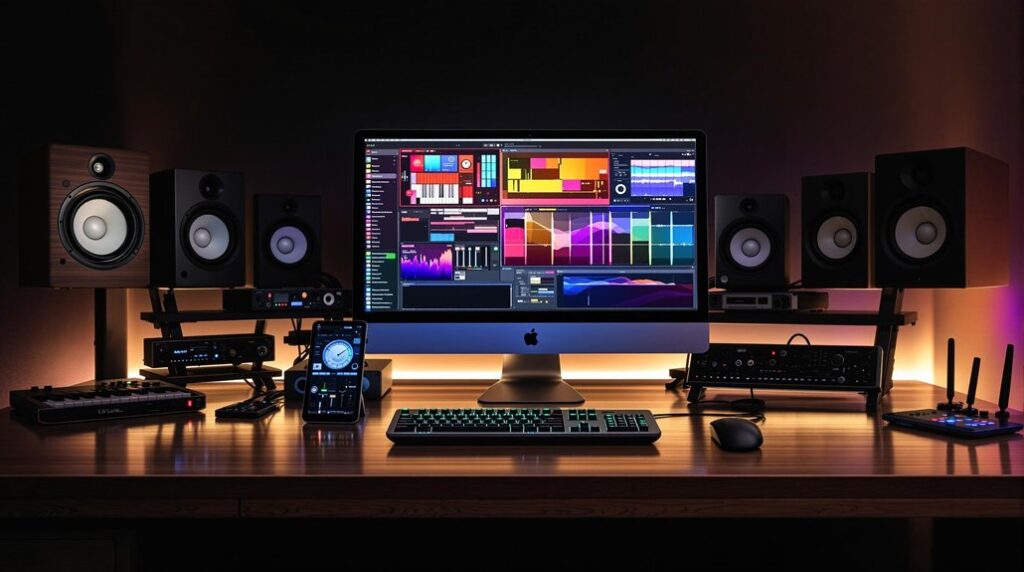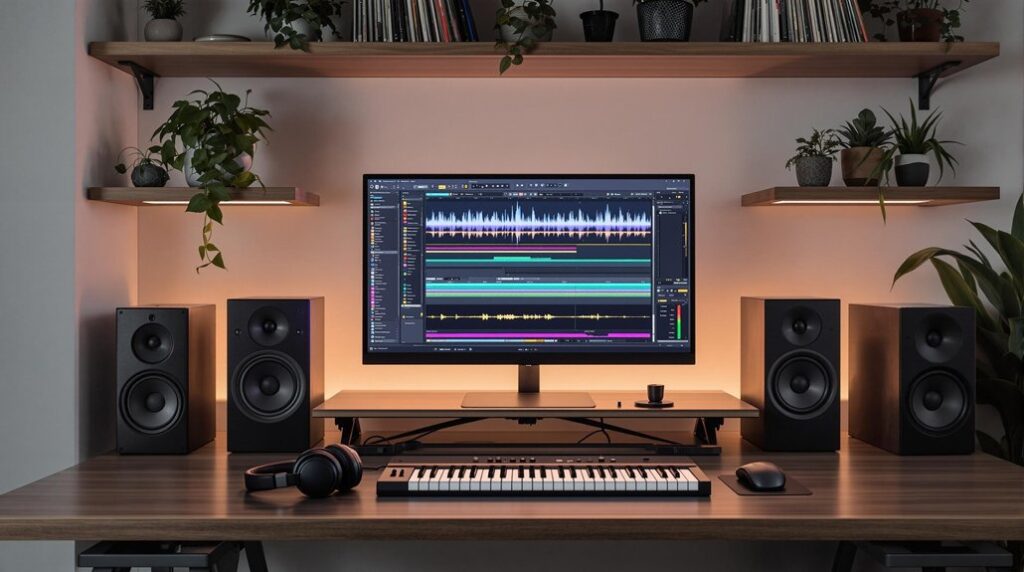Mastering tempo in Ableton is key to transforming your music. Start by understanding Scene Tempo to establish a solid BPM foundation for each section. Activate Tempo Controls via the View menu, adding clarity and ease to your adjustments. Fine-tune BPM within scenes, and set custom time signatures for unique rhythmic flavors. Automate tempo changes for dynamic shifts, enhancing your track’s flow. Explore warping modes for innovative sound manipulation, while best practices guarantee effective tempo management throughout your project. With these steps, you’ll reveal creative potential and raise your music to new heights—there’s plenty more to discover that’ll refine your skills further.
Key Takeaways
- Access and enable Tempo and Time Signature controls from the View menu for easy adjustments in Ableton Live.
- Set individual BPM for each scene to create dynamic shifts in rhythm and energy throughout your composition.
- Use the tempo field in the Scene Header to manually input and fine-tune BPM values as needed.
- Automate tempo changes by creating automation nodes on the Master track for smooth transitions between different BPMs.
- Regularly refer to the Ableton Live Reference Manual for techniques and best practices in tempo management and adjustments.
Understanding Scene Tempo
When you plunge into the world of Ableton Live, understanding Scene Tempo can transform your musical compositions. This feature allows you to set a specific BPM for each scene, enhancing the dynamic structure of your arrangement.
You can easily adjust the tempo within a range of 20 to 999 BPM, giving you the flexibility to express various musical energies. In Session View, you can automate tempo changes by right-clicking the tempo field, creating a more engaging listening experience.
Additionally, in Live 10, scene names can include tempo designations, making it simple to identify your desired tempo during the creative process. Embracing Scene Tempo will raise your compositions, allowing for innovative shifts and a enthralling flow. Understanding how to manipulate energy flow effectively can further enhance your compositions.
Enabling Tempo Controls
To access the full potential of tempo manipulation in Ableton Live, you need to enable Scene Tempo and Time Signature controls.
In Ableton Live 12, simply navigate to the View menu and select the appropriate option. For Live 11 and earlier, drag the left edge of the Master track to reveal these controls.
Once activated, you can switch to Scene View by double-clicking the Scene Header, allowing you to make specific tempo adjustments for each scene. The tempo field will then appear in the top left corner, where you can manually input BPM values between 20 and 999.
With these settings visible in the Master track, you’re all set for dynamic tempo management throughout your project. Additionally, using the Tempo List Editor will enable precise adjustments to the BPM for individual tracks, enhancing your overall production quality.
Adjusting BPM in Scenes
Adjusting the BPM in scenes allows you to tailor your music’s energy and feel with precision.
In Ableton Live, you can easily adjust BPM by clicking the tempo field in the Scene Header, entering your desired value, or using the arrow keys for fine-tuning. If you prefer a more tactile approach, drag with your cursor for intuitive changes.
Each scene can have its own Scene Tempo, and you can also set time signature changes by clicking the Time Signature field. Creative exploration of time signatures can lead to innovative rhythms that enhance your music projects.
To enhance clarity, consider naming your scenes with the BPM and time signature formats.
If you want dynamic shifts, you can automate tempo changes, giving your compositions depth and variation in Session View.
Setting Time Signatures
Setting the time signature in Ableton Live opens up a world of rhythmic possibilities, allowing you to craft the precise feel and groove of your music. By clicking on the Time Signature field, you can select the desired numerator (beats per bar) and denominator (beat value) from the dropdown menu, considerably altering your track’s rhythmic structure.
| Time Signature | Description |
|---|---|
| 4/4 | Common time, feels stable |
| 3/4 | Waltz feel, flowing |
| 6/8 | Compound time, lively |
| Custom | Tailored to your style |
With numerators ranging from 1 to 99 and denominators of 1, 2, 4, 8, or 16, you can easily change the BPM and explore diverse grooves! Understanding 9/8 time signature can further enhance your rhythmic creativity and versatility in music production.
Automating Tempo Changes
While you might think of tempo as a fixed element, automating tempo changes in Ableton Live allows you to inject dynamic energy into your tracks.
Here’s how to effectively implement tempo automation:
- Right-click the tempo box in the Arrangement View to show the automation lane.
- Create automation nodes by clicking the line to set specific BPM values at desired points.
- Adjust these nodes by right-clicking and entering your desired BPM for precise changes.
- Smooth shifts are essential; adjust the curve between nodes for gradual transitions.
Utilizing tempo automation on the Master track lets you control the overall pace, enhancing the dynamic flow and aligning with your desired scene, ultimately elevating your music’s tempo and time signature. Additionally, understanding quantization techniques will help ensure that your tempo changes work harmoniously with your musical elements.
Exploring Warping Modes
When you’re working with tempo in Ableton, understanding the different warping modes is essential for achieving the sound you want.
Each mode—whether it’s Beats for your percussion or Complex Pro for full mixes—affects your audio quality and character in unique ways.
Choosing the right warp mode not only preserves your track’s integrity but can also enhance your creative possibilities. Additionally, the innovative features like Session View provide a unique environment for experimenting with these warp modes in real-time.
Understanding Warp Mode Types
Ableton Live’s warp modes reveal a world of creative possibilities, allowing you to manipulate audio with precision tailored to your material.
Understanding these modes is essential for effective time-stretching and maintaining audio integrity. Here’s a quick rundown of the primary options:
- Complex Pro: Best for full tracks, preserving quality during extensive time-stretching.
- Beats: Ideal for rhythmic material, focusing on transient preservation to maintain groove.
- Tones: Optimized for melodic content, ensuring pitch integrity for vocals and guitars.
- Re-Pitch: Changes pitch alongside tempo, great for unique sound effects, but not always suitable for every audio type.
Choosing the right warp mode can enhance your projects and boost your creative output considerably.
Choosing Appropriate Warp Mode
Selecting the right warp mode can greatly impact your project’s sound and feel. When you need to change the BPM, consider the type of audio you’re working with.
For full tracks, use Complex Pro; it preserves audio quality during significant tempo adjustments. If you’re dealing with rhythmic content, Beats mode is your go-to, emphasizing transients for a punchy drum sound.
For melodic instruments, Tones mode guarantees pitch stability, making it perfect for vocals or guitars. Conversely, if you want a straightforward approach, Re-Pitch alters both pitch and speed simultaneously, simplifying tempo changes.
Choose wisely: the appropriate warp mode enhances your mix, keeping the essence of your sound intact while maneuvering the intricacies of tempo manipulation.
Impact on Audio Quality
The impact of warping modes on audio quality is profound, influencing how your tracks resonate. Choosing the right mode can mean the difference between clarity and distortion, especially when adjusting tempo.
Here’s a quick overview of how different warping modes affect sound integrity:
- Complex and Complex Pro: Alter sound quality when changing tempos.
- Beats, Tones, Texture: Maintain audio integrity if tempos align.
- Rhythmic vs. Melodic: Select modes based on content type.
- Experimentation: Understanding modes enhances flexibility in tempo adjustments.
Always consult the Ableton Live manual to grasp specific behaviors of each warping mode.
Best Practices for Tempo Management
Establishing a solid tempo foundation is essential for any successful music project. Start by setting the desired BPM before you immerse yourself in recordings, ensuring coherence throughout your session.
Use the Scene Tempo controls to assign specific BPM values to each scene, allowing for dynamic tempo changes that can enhance your composition. Automate shifts by creating nodes in the Master Track header’s tempo lane; this enables smooth transitions between different segments.
Don’t hesitate to experiment with a range of tempos (20-999 BPM) to discover unique rhythms that inspire your creativity. Additionally, incorporating automation techniques can greatly enhance your ability to create dynamic shifts in your music.
Finally, regularly consult the Ableton Live Reference Manual for invaluable insights on tempo adjustments and best practices for tempo management. This will keep your project organized and impactful.
Frequently Asked Questions
How Do You Automate BPM Change in Ableton?
To automate BPM in Ableton, use the automation lane for creative tempo changes. Employ tempo modulation tips, implement tempo mapping strategies, and guarantee smooth shifts for dynamic live performance automation. Experiment with BPM automation techniques for enhanced arrangements.
How Do I Change My BPM Without Stretching Audio?
To change your BPM settings without stretching audio, disable warping on audio clips. Set your global tempo, adjust clip envelopes, and use appropriate warp modes while maintaining the desired time signature for accurate tempo mapping.
How Do I Change the BPM of a MIDI Clip in Ableton?
To change the BPM of a MIDI clip, adjust the clip settings in the Clip View. Set the project tempo, utilize warp modes for tempo adjustments, and manage automation lanes to sync with your time signature.
How Do I Have Two Different BPM in Ableton?
To achieve two different BPMs in Ableton, employ BPM switching techniques, use tempo mapping essentials, and apply mixing different tempos. This enhances creative tempo variations, ensuring syncing instruments effectively for dynamic, multi-tempo compositions during your live performance.
Conclusion
Mastering tempo in Ableton is a game changer for your music production. By understanding scene tempo, enabling controls, and automating changes, you can create dynamic tracks that keep listeners engaged. Don’t forget to explore warping modes and set time signatures that enhance your compositions. With these seven steps, you’ll not only manage your BPM effectively but also raise your sound to new heights. Embrace these techniques, and watch your creativity flourish!




